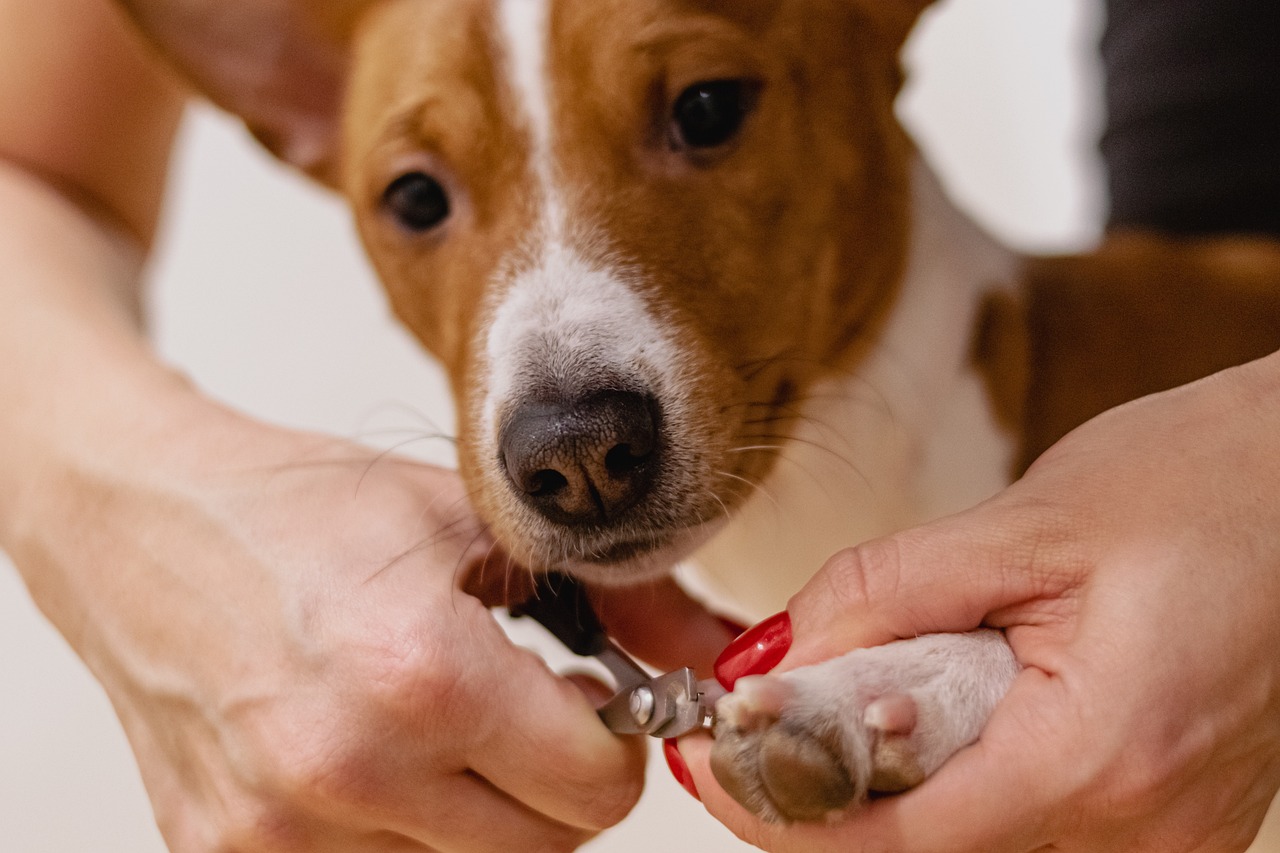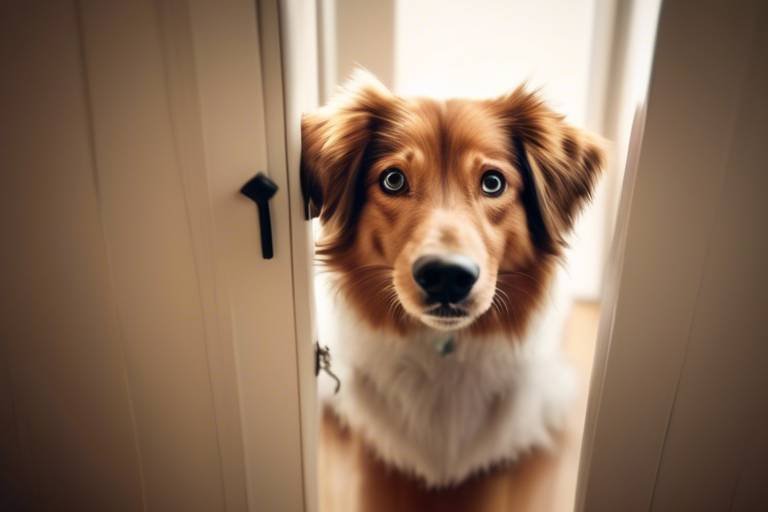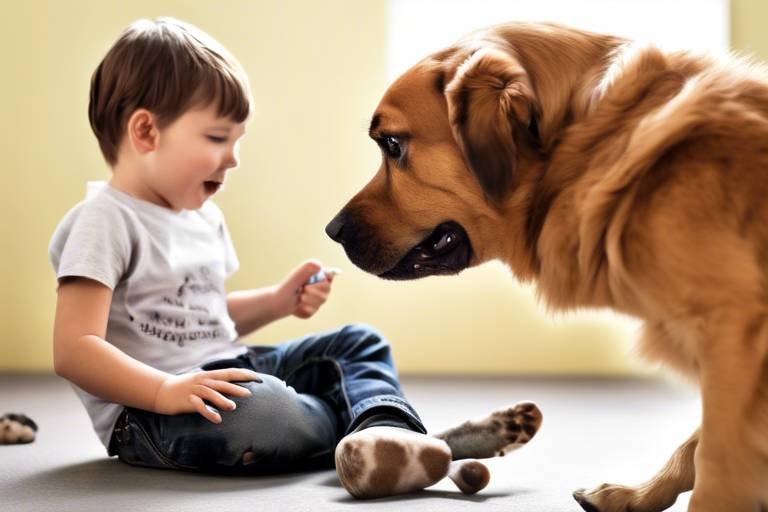How to Help Your Pet Overcome Agoraphobia
Agoraphobia isn't just a human condition; it can affect our furry friends too. Imagine your pet, once full of energy and excitement, suddenly becoming fearful of open spaces or unfamiliar environments. It's heart-wrenching to witness. But the good news is that with the right strategies and a whole lot of love, you can help your pet regain their confidence and enjoy life to the fullest. In this article, we'll explore effective techniques to assist your pet in overcoming agoraphobia, from understanding the condition to creating a safe space and gradually exposing them to new experiences.
Agoraphobia in pets can significantly impact their quality of life. This anxiety disorder can lead to a range of symptoms that manifest both physically and behaviorally. It’s important to understand that this isn't just a phase; it's a genuine condition that can stem from various causes, including traumatic experiences or a lack of socialization. Pets suffering from agoraphobia might exhibit behaviors such as avoiding certain areas of the house, excessive barking, or even hiding when faced with open spaces. Understanding these symptoms is the first step in helping your pet on their journey to recovery.
Identifying the signs of anxiety in your pet is crucial for effective intervention. Pets can't express their feelings in words, so it's up to us to be observant and perceptive. Common behaviors indicating that your pet may be struggling with agoraphobia include:
- Trembling or shaking when exposed to open spaces.
- Panting excessively, even when it's not hot.
- Excessive barking at unfamiliar sounds or sights.
These physical symptoms can help you recognize when your pet is feeling overwhelmed. But there are also behavioral changes to watch for.
Physical manifestations of anxiety can include trembling, panting, and excessive barking. These signs are often your pet's way of communicating discomfort or fear. For instance, if you notice your dog trembling at the sound of thunder or panting when you take them outside, it may be a clear indication that they're feeling anxious. Understanding these symptoms helps pet owners recognize when their pets are feeling overwhelmed and need support.
Changes in behavior such as withdrawal, aggression, or destructive tendencies can signal anxiety. For example, if your once-friendly cat starts hiding under the bed or your dog begins to act aggressively towards strangers, these could be signs of deeper issues. Observing these changes is crucial for early intervention, allowing you to address the root cause of your pet's anxiety before it escalates.
Certain environmental factors can exacerbate anxiety in pets. Loud noises, busy streets, or even other animals can trigger feelings of fear and panic. Identifying these triggers in your pet's surroundings is essential for creating a supportive environment that minimizes anxiety-inducing situations. For instance, if your dog is scared of loud fireworks, keeping them indoors during celebrations may help.
Emotional signs, such as clinginess or excessive fear, can indicate agoraphobia. If your pet suddenly becomes overly attached to you, following you everywhere, it may be their way of seeking comfort. Learning to interpret these signals can guide pet owners in providing the necessary support. Just like humans, pets need reassurance and love to feel safe.
Establishing a safe and comforting environment is essential for helping pets cope with agoraphobia. This can be achieved by creating a designated area in your home where your pet can retreat when feeling anxious. Consider using familiar items, like blankets or toys, to ease anxiety. These comfort items can work wonders, providing a sense of security that helps your pet feel more at ease in their surroundings.
Incorporating familiar items, like blankets or toys, can ease anxiety. When your pet has access to their favorite toys or a cozy blanket, it can significantly reduce their stress levels. These items serve as a reminder of home and safety, helping to ground them during moments of fear.
Designating quiet areas in your home allows pets to retreat when feeling anxious. Consider setting up a corner with their bed, some toys, and perhaps a few treats. This calming space can become their sanctuary, a place where they can relax and feel secure away from the hustle and bustle of daily life.
Gradual exposure is a key method for helping pets overcome agoraphobia. This technique involves slowly introducing your pet to new environments and experiences in a controlled manner. Start with short trips outside or brief visits to less crowded areas, gradually increasing exposure as your pet becomes more comfortable.
Desensitization involves exposing pets to anxiety-inducing situations in a controlled manner. For example, if your dog is scared of the car, start by letting them sit in the car with the engine off, rewarding them with treats and praise. Gradually increase the exposure by taking short drives, ensuring that the experience remains positive.
Using positive reinforcement can encourage pets to face their fears. Reward systems can be incredibly effective during exposure exercises. For instance, if your pet successfully navigates a new environment, shower them with treats and affection. This creates a positive association with the experience, motivating them to continue progressing.
Sometimes, professional intervention is necessary for severe cases of agoraphobia. If your pet's anxiety is significantly impacting their quality of life, it may be time to consult a veterinarian or animal behaviorist for additional support. They can provide tailored strategies and recommendations that suit your pet's specific needs.
Behavioral therapy can provide structured support for anxious pets. This may include techniques such as counter-conditioning or training sessions designed to help your pet build confidence. A professional can guide you through these processes, ensuring that your pet receives the best care possible.
In some cases, medication may be required to manage anxiety. While this should not be the first option, it can be beneficial for pets with severe anxiety. Discussing the potential benefits and considerations of using medication with your veterinarian can help you make an informed decision that prioritizes your pet's well-being.
Regularly monitoring your pet's progress is essential for effective treatment. Keep track of their reactions to new environments and experiences, noting any improvements or setbacks. This will help you adjust your strategies as needed and ensure that your pet is on the right path to recovery.
Establishing achievable goals helps maintain motivation. Rather than expecting your pet to overcome their fears overnight, set small, realistic milestones. Celebrate each achievement, no matter how minor, as these victories contribute to your pet's overall progress.
Recognizing and celebrating small achievements can boost your pet's confidence. Whether it's a successful trip to the park or simply exploring a new room in the house, acknowledging these moments reinforces positive behavior and encourages your pet to keep pushing forward.
Q: Can all pets develop agoraphobia?
A: Yes, any pet can develop agoraphobia, but it's more common in those with a history of trauma or lack of socialization.
Q: How long does it take for a pet to overcome agoraphobia?
A: The duration varies based on the pet's individual circumstances, but with patience and consistent effort, improvement can often be seen within weeks to months.
Q: Should I use medication for my pet's anxiety?
A: Medication can be an option for severe cases, but it's important to consult with a veterinarian to discuss the best approach for your pet.
Q: What if my pet doesn't respond to gradual exposure techniques?
A: If your pet isn't responding, consider seeking professional help from a veterinarian or animal behaviorist who can provide tailored strategies.

Understanding Agoraphobia in Pets
Agoraphobia in pets is a condition that can deeply impact their overall well-being and quality of life. Just like humans, animals can develop an intense fear of open spaces or unfamiliar environments, which can lead to avoidance behaviors that limit their activities. This condition often manifests in various ways, making it crucial for pet owners to recognize and understand the symptoms. The underlying causes of agoraphobia can range from traumatic experiences to genetic predispositions, and understanding these factors is vital for effective intervention.
When we talk about agoraphobia in pets, we're not just referring to a simple dislike of going outside. It's a complex anxiety disorder that can stem from numerous factors, including:
- Past Trauma: Pets that have experienced traumatic events, such as abandonment, abuse, or accidents, may develop a heightened fear of open spaces.
- Genetic Factors: Certain breeds are more prone to anxiety disorders, which can include agoraphobia.
- Environmental Changes: Moving to a new home or changes in the household can trigger anxiety in sensitive pets.
It's essential to be aware of the behavioral patterns associated with this anxiety disorder. Pets suffering from agoraphobia may display a range of symptoms that can be alarming to their owners. Common signs include:
- Refusal to leave the house
- Excessive whining or barking when near doors or windows
- Hiding or seeking refuge in small, enclosed spaces
Understanding these symptoms can help pet owners take appropriate action to assist their furry friends. It’s not just about recognizing the signs; it’s about empathizing with their experience. Imagine how overwhelming it must be for a pet to feel trapped in their own home, unable to enjoy the simple pleasures of a walk in the park or a romp in the backyard. This emotional distress can lead to a cycle of fear and avoidance, making it increasingly difficult for pets to overcome their anxiety.
In summary, recognizing and understanding agoraphobia in pets is the first step towards helping them regain their confidence and joy. By being attuned to their emotional and physical needs, pet owners can create a supportive environment that fosters healing and growth.

Recognizing Signs of Anxiety
Recognizing the signs of anxiety in your pet is crucial for effective intervention. Just like us, pets can experience a range of emotions, and their anxiety can manifest in various ways. Understanding these signs can help you take appropriate action before the situation escalates. Imagine your pet as a little detective, trying to communicate their feelings without words. It’s up to us to decode their behaviors and provide the support they need.
One of the most common indicators of anxiety is physical symptoms. These can include trembling, panting, excessive barking, or even hiding. For instance, if you notice your dog shaking uncontrollably or your cat panting heavily during a thunderstorm, these are clear signs that they are feeling overwhelmed. It's important to observe these physical manifestations closely, as they can serve as a warning signal that your pet is struggling.
Physical symptoms of anxiety can vary widely among different pets. Here are some common signs to look for:
- Trembling: Shaking or shivering can indicate fear or anxiety.
- Panting: Rapid breathing, especially when not exercising, can be a sign of distress.
- Excessive barking or meowing: Vocalizations may increase when a pet is anxious.
Next, let’s talk about behavioral changes. Changes in your pet's behavior can be a telltale sign that something isn’t right. For example, if your usually playful dog suddenly becomes withdrawn or starts exhibiting aggressive behavior, it’s time to pay attention. Destructive tendencies, like chewing on furniture or scratching at doors, can also indicate that your pet is feeling anxious and doesn’t know how to cope.
Behavioral changes can be subtle or dramatic, and it’s essential to recognize them early. Here are some indicators to watch for:
- Withdrawal: If your pet is hiding or avoiding social interactions, they may be feeling anxious.
- Aggression: An anxious pet might lash out unexpectedly.
- Destructive behavior: Chewing or scratching can be a sign of pent-up anxiety.
Another critical aspect to consider is the environmental triggers that may exacerbate anxiety. Pets are sensitive to their surroundings, and certain factors can heighten their stress levels. For instance, loud noises, unfamiliar people, or even changes in routine can create a sense of unease for your furry friends. Identifying these triggers is key to helping your pet feel more secure.
To help your pet, you should observe their reactions to various situations and environments. Common triggers include:
- Fireworks or thunderstorms: Many pets are frightened by loud noises.
- New people or pets: Changes in the household can create anxiety.
- Changes in routine: Pets thrive on routine, and disruptions can lead to stress.
Lastly, let’s not forget about the emotional indicators that can signal agoraphobia. Pets often express their feelings through their emotional state. Signs like clinginess, excessive fear, or even a lack of interest in activities they once enjoyed can indicate that your pet is struggling with anxiety. Just like a child who clings to their parent in a crowded place, your pet may seek reassurance when they feel scared.
Understanding these emotional signs can guide you in providing the necessary support. Pay attention to how your pet reacts in different situations. If they seem overly fearful or cling to you more than usual, it’s time to take action. Learning to interpret these signals can make a world of difference in your pet's life.
In conclusion, recognizing the signs of anxiety in your pet is the first step toward helping them overcome their fears. By being vigilant and observant, you can create a supportive environment that fosters their well-being and confidence. Remember, your furry friend relies on you to be their advocate, so don’t hesitate to take action if you notice any of these signs.
Q: How can I tell if my pet is anxious?
A: Look for physical symptoms like trembling, panting, or excessive vocalizations, as well as behavioral changes such as withdrawal or aggression.
Q: What should I do if I notice signs of anxiety in my pet?
A: Start by creating a safe and comforting environment, and consider gradual exposure techniques to help them cope with their fears.
Q: When should I seek professional help for my pet's anxiety?
A: If your pet’s anxiety is severe or not improving with home strategies, it may be time to consult a veterinarian or an animal behaviorist.
Physical Symptoms
When it comes to understanding how agoraphobia manifests in our furry friends, paying attention to is crucial. Pets can’t exactly tell us what they're feeling, so we must become keen observers of their behavior. Common signs of anxiety include trembling, panting, and excessive barking. These symptoms often escalate when your pet is faced with open spaces or unfamiliar environments. For instance, you might notice your dog shaking uncontrollably as you approach the front door or hear your cat meowing loudly when you try to take them outside.
It's essential to recognize that these physical manifestations are not just mere quirks; they are your pet's way of communicating distress. A trembling pet might be experiencing an overwhelming sense of fear, while panting can indicate a heightened state of anxiety. Moreover, excessive barking can be a cry for help, signaling that your pet feels threatened or uncomfortable in their surroundings. Understanding these signs can empower you to take action before the situation worsens.
In addition to the more obvious symptoms, there are subtler signs that might indicate your pet is struggling with anxiety. For example, you might observe:
- Increased heart rate: Just like us, pets can have a racing heart when they feel anxious.
- Loss of appetite: If your pet suddenly refuses to eat, it could be a response to anxiety.
- Excessive grooming: Some pets may lick themselves excessively as a way to cope with stress.
These physical symptoms can vary greatly among different animals, so it’s important to be familiar with what’s typical for your pet. For instance, a normally calm dog might bark incessantly when faced with a new environment, while a cat may hide and refuse to come out. Being aware of these changes in behavior can help you intervene early and provide the support your pet needs.
Furthermore, if you find that your pet exhibits any of these symptoms frequently, it may be beneficial to keep a journal of their behavior. Document the situations that trigger their anxiety and the physical symptoms that arise. This record can be invaluable when discussing your pet's condition with a veterinarian or animal behaviorist, as it provides concrete evidence of their struggles.
In summary, recognizing the physical symptoms of agoraphobia in pets is a vital step in helping them navigate their fears. By being observant and proactive, you can create a nurturing environment that fosters their confidence and well-being.
Behavioral Changes
When it comes to understanding your pet's emotional state, behavioral changes can be some of the most telling indicators of underlying anxiety, particularly in cases of agoraphobia. Pets are often unable to express their feelings verbally, which means it's up to us as their guardians to observe their behavior closely. You might notice your furry friend becoming more withdrawn or even displaying signs of aggression that are out of character. For instance, a dog that once loved to greet visitors might suddenly bark excessively or hide when someone new enters the home. This shift can be alarming, but it's essential to recognize it as a cry for help.
Moreover, destructive tendencies can also emerge as a way for pets to cope with their anxiety. Chewing on furniture, scratching at doors, or even having accidents in the house can all be manifestations of stress. These behaviors are not merely acts of rebellion; they often stem from fear and the need to express discomfort in a world that feels overwhelming to them.
To help you identify these changes more effectively, here are some common behavioral changes to watch for:
- Withdrawal: Your pet may start isolating themselves, preferring to stay in a corner or under a bed rather than engaging with family members.
- Aggression: Increased aggression towards other pets or people can signal heightened anxiety levels.
- Destructive Behavior: Chewing, digging, or scratching may occur as an outlet for pent-up anxiety.
- Increased Vocalization: Excessive barking, whining, or meowing can indicate distress.
Recognizing these behavioral changes is crucial for early intervention. It’s important to take note of when these behaviors occur and what might trigger them. For instance, does your pet act out when you prepare to leave the house, or do they seem more anxious during thunderstorms? Keeping a behavior journal can be a helpful tool for tracking these patterns and identifying potential triggers.
Understanding the root causes of these changes can also guide your approach to helping your pet. For example, a pet that exhibits aggression may be reacting out of fear rather than a desire to be hostile. By addressing the underlying anxiety, you can work towards restoring your pet’s sense of safety and comfort.
In summary, paying attention to behavioral changes is vital in managing your pet's anxiety. By being observant and proactive, you can create a more supportive environment that encourages your pet to feel secure and loved. Remember, every small step you take can make a significant difference in your pet's journey towards overcoming agoraphobia.
Q1: What should I do if I notice behavioral changes in my pet?
A1: If you observe significant behavioral changes, it’s important to consult with a veterinarian or animal behaviorist to rule out any underlying health issues and to develop a tailored approach to address your pet's anxiety.
Q2: Can I help my pet overcome agoraphobia on my own?
A2: While you can implement various strategies at home, such as creating a safe space and using gradual exposure techniques, it’s often beneficial to seek professional guidance for severe cases.
Q3: How long does it take for a pet to overcome agoraphobia?
A3: The duration varies depending on the severity of the condition and the individual pet. Consistent efforts, patience, and positive reinforcement can lead to gradual improvements over time.
Environmental Triggers
Understanding the that can exacerbate your pet's agoraphobia is crucial for effective management. Just like humans, pets can be sensitive to their surroundings, and certain stimuli can heighten their anxiety levels. These triggers can range from loud noises to unfamiliar scents, and recognizing them is the first step in creating a supportive environment.
For instance, consider how a sudden thunderstorm might send your pet into a panic. The loud claps of thunder can create a sense of chaos that overwhelms them. Similarly, fireworks on holidays can lead to distress, causing pets to seek refuge in the safest corners of your home. Other common environmental triggers include:
- Strange People or Animals: New faces or unfamiliar pets can induce fear. Your pet may feel threatened or anxious in their presence.
- Traffic Sounds: The noise from cars, trucks, and sirens can be unsettling. Pets may associate these sounds with danger, leading to heightened anxiety.
- Changes in Routine: Pets thrive on consistency. Any alterations in their daily routine, such as changes in feeding times or walking schedules, can create stress.
- New Environments: Moving to a new home or visiting unfamiliar places can trigger anxiety. The new smells, sounds, and sights can be overwhelming.
To effectively identify these triggers, it’s essential to observe your pet's reactions in different situations. Keep a journal to note when your pet seems particularly anxious and what environmental factors might be involved. This record can help you pinpoint specific triggers and develop strategies to minimize their impact.
Additionally, consider creating a safe zone within your home where your pet can retreat when feeling overwhelmed. This area should be quiet, free from distractions, and filled with their favorite comfort items. By understanding and mitigating these environmental triggers, you can help your furry friend feel more secure and gradually build their confidence in facing the outside world.
Q: How can I tell if my pet is experiencing agoraphobia?
A: Look for signs such as excessive barking, trembling, or hiding when faced with open spaces or unfamiliar environments. Behavioral changes like aggression or withdrawal can also indicate anxiety.
Q: What should I do if I identify environmental triggers?
A: Once you identify triggers, try to minimize exposure to them. Create a safe space for your pet and gradually introduce them to the triggers in a controlled manner, using positive reinforcement.
Q: Can training help my pet with agoraphobia?
A: Yes! Training techniques, especially desensitization and positive reinforcement, can be very effective in helping your pet cope with their fears. Consulting a professional trainer can provide additional guidance.
Q: Is medication necessary for pets with agoraphobia?
A: In severe cases, medication may be necessary to help manage anxiety. It's important to consult a veterinarian to discuss the best options for your pet.
Emotional Indicators
Understanding the emotional landscape of your pet is crucial when addressing agoraphobia. Pets, like humans, experience a wide range of emotions, and their feelings can often manifest in subtle yet significant ways. One of the most telling signs of agoraphobia is clinginess. If your pet suddenly becomes overly attached, following you around the house or refusing to leave your side, it could be a cry for help. This behavior indicates that your furry friend is feeling insecure and anxious, desperately seeking comfort and reassurance.
Another emotional indicator to watch for is excessive fear. If your pet exhibits signs of panic when exposed to open spaces or unfamiliar environments, this is a clear sign that they are struggling with anxiety. You may notice them trembling, hiding, or even trying to escape when faced with situations that trigger their fear. This intense reaction can be distressing for both you and your pet, highlighting the importance of recognizing these emotional signals early on.
Additionally, changes in your pet's social behavior can serve as emotional indicators. For instance, if your once-social dog suddenly becomes withdrawn or aggressive, it may be a sign that they are overwhelmed by their surroundings. This shift in behavior can stem from a fear of the unknown, making it vital for you to observe and understand these changes. By paying attention to their emotional state, you can better support your pet during this challenging time.
To help you identify these emotional indicators, consider the following key signs:
- Clinginess: Seeking constant companionship and not wanting to be left alone.
- Excessive fear: Displaying panic or distress in open spaces or unfamiliar settings.
- Withdrawal: Isolating themselves from family members or other pets.
- Aggression: Reacting defensively or aggressively when feeling threatened.
Recognizing these emotional indicators is the first step in helping your pet cope with agoraphobia. By being attentive and responsive to their needs, you can create a supportive environment that fosters their confidence and emotional well-being.
Q: How can I tell if my pet has agoraphobia?
A: Look for signs like clinginess, excessive fear in open spaces, withdrawal from social interactions, and aggressive behavior during stressful situations. If these behaviors are present, it may indicate agoraphobia.
Q: What should I do if I suspect my pet has agoraphobia?
A: Start by observing your pet's behavior closely and create a safe space at home. Gradual exposure to new environments can help, but if the symptoms persist, consult a veterinarian or an animal behaviorist for professional guidance.
Q: Are there specific breeds that are more prone to agoraphobia?
A: While any pet can develop agoraphobia, certain breeds that are more sensitive or have a history of anxiety may be at a higher risk. It's essential to monitor your pet's behavior regardless of breed.
Q: Can medication help my pet with agoraphobia?
A: In some cases, medication may be necessary to help manage anxiety. Consult your veterinarian to discuss the potential benefits and risks associated with medication for your pet.

Creating a Safe Space
Creating a safe and comforting environment for your pet is not just a good idea; it’s essential for helping them cope with agoraphobia. Imagine how you would feel if you were constantly surrounded by things that made you anxious—it's overwhelming, right? Now, think about your furry friend. They experience similar feelings, and it's up to us as their guardians to help them feel secure. Start by identifying a specific area in your home where your pet can retreat when they feel anxious. This space should be cozy, quiet, and away from the hustle and bustle of daily life. Consider using a corner of a room, a closet, or even a cozy crate where they can feel protected.
To enhance this safe space, incorporate comfort items that your pet loves. Familiar scents and textures can work wonders in alleviating anxiety. For instance, you might include their favorite blanket, a plush toy, or even an item of your clothing. These items can provide a sense of security, much like a child with a beloved stuffed animal. Additionally, ensure that this area is free from loud noises and sudden movements, as these can trigger anxiety.
Creating a designated quiet area is only part of the equation. You should also consider the layout of your home and how it affects your pet's feelings. Open spaces can be intimidating for pets suffering from agoraphobia. Therefore, think about rearranging furniture or using barriers to create a more enclosed environment. This can help your pet feel more secure and less exposed. You might also want to use calming colors and soft lighting in this area to create a serene atmosphere.
Furthermore, it’s important to establish a routine that includes time spent in this safe space. Encourage your pet to use this area during stressful times, such as when there are loud noises outside or when visitors come over. By consistently reinforcing this behavior, you’ll help your pet associate this space with safety and comfort. Over time, they’ll learn to retreat there when they feel anxious, making it a sanctuary of sorts.
Lastly, remember that patience is key. It may take time for your pet to feel truly comfortable in their safe space. Be sure to celebrate small victories along the way, such as them spending time in their designated area without prompting. Each step forward is a sign of progress, and with your support, they can learn to navigate their fears more effectively.
- How can I tell if my pet is using their safe space? Look for signs that they are retreating there when they feel anxious, such as spending time there during thunderstorms or when guests arrive.
- What items should I include in my pet's safe space? Include familiar items like blankets, toys, and your clothing to provide comfort and security.
- Can I train my pet to use their safe space? Yes! Use positive reinforcement to encourage your pet to go to their safe space when they feel anxious.
Comfort Items
When it comes to helping your furry friend tackle agoraphobia, play a crucial role. These are not just mere toys or objects; they are the lifelines that can provide a sense of security and familiarity in an otherwise overwhelming world. Imagine how a child feels when they clutch their favorite stuffed animal during a thunderstorm—pets experience similar emotions and need their own comforting items to navigate their fears.
One of the most effective ways to create a sense of safety is by incorporating familiar items into your pet's environment. Think about their favorite blanket, a worn-out toy, or even a piece of your clothing. These objects carry their own unique scent, which can be incredibly soothing. For instance, a soft blanket can act as a cozy haven, allowing your pet to burrow in and feel shielded from the outside world. Similarly, a beloved toy can serve as a distraction, providing a sense of normalcy during stressful situations.
In addition to personal items, consider investing in specialized comfort products designed for anxious pets. These can include:
- Calming wraps: These snug garments apply gentle pressure, mimicking the feeling of being held, which can help reduce anxiety.
- Noise-canceling headphones: If your pet is particularly sensitive to sounds, these can help mute the outside noise that triggers their anxiety.
- Comforting pheromone diffusers: These products release calming scents that can help ease your pet's stress levels.
Creating a comforting environment is not just about the items you provide; it's also about how you use them. Designate a specific area in your home as a safe zone where your pet can retreat whenever they feel anxious. This space should be stocked with their comfort items, allowing them to feel secure and relaxed. You might even consider adding some soft lighting and calming music to enhance the peaceful atmosphere.
Ultimately, the goal is to help your pet associate their comfort items with safety and tranquility. By creating a nurturing environment filled with familiar scents and soothing objects, you're not just alleviating their anxiety—you're also fostering a deeper bond of trust between you and your pet. Remember, every small step counts, and with patience and love, you can help your furry companion feel more at ease in the world around them.
Q: What types of comfort items are best for pets with agoraphobia?
A: The best comfort items include familiar blankets, favorite toys, and even your clothing. Additionally, consider calming wraps, pheromone diffusers, and noise-canceling headphones.
Q: How can I encourage my pet to use their comfort items?
A: You can encourage your pet to use their comfort items by placing them in their designated safe space and spending time with them there. Engage with them using their toys to create positive associations.
Q: Can comfort items really help with severe anxiety?
A: While comfort items are not a cure-all, they can significantly help reduce anxiety levels and provide a sense of security. For severe cases, it's best to consult with a veterinarian or animal behaviorist for a comprehensive approach.
Designated Quiet Areas
Creating in your home is a crucial step in helping your pet manage their agoraphobia. These spaces serve as safe havens where your furry friend can retreat when feeling anxious or overwhelmed. Think of it as a cozy sanctuary, a little slice of heaven where your pet can unwind and feel secure. It's essential to choose a location that is away from the hustle and bustle of daily life—perhaps a quiet corner in a room or a cozy nook under the stairs.
When setting up these areas, consider incorporating items that provide comfort and familiarity. For instance, you might include their favorite blanket, a plush bed, or even some cherished toys. These comfort items can significantly reduce anxiety and help your pet associate the space with safety and relaxation. Remember, the goal is to create a calming environment that encourages your pet to seek refuge when they need it most.
Another important aspect of these quiet areas is minimizing noise and distractions. If possible, use soundproofing techniques, such as heavy curtains or rugs, to dampen any external noise that might trigger anxiety. You can also consider using a white noise machine to drown out unsettling sounds, creating a soothing auditory backdrop. This approach can make a world of difference for a pet struggling with agoraphobia.
Moreover, it’s beneficial to regularly check in on your pet while they’re in their quiet area. This not only reinforces the idea that this space is safe but also allows you to monitor their behavior and emotional state. If you notice them spending more time in their designated space, it could indicate that they are finding comfort there. On the other hand, if they seem reluctant to use the space, it may be time to reassess the setup and make adjustments to better cater to their needs.
Ultimately, the key to successful designated quiet areas is to ensure they are inviting and comforting. With the right setup, your pet can learn that it’s okay to step back from the chaos of the outside world and find solace in their own little retreat.
- How can I tell if my pet is using their quiet area? Regularly observe your pet's behavior. If they frequently retreat to that space, it’s a good sign they find it comforting.
- What items should I include in the quiet area? Consider soft bedding, favorite toys, and familiar scents like a blanket or an item of your clothing to help them feel secure.
- Can I use calming music in the quiet area? Yes, soft, calming music can enhance the soothing atmosphere of the quiet area.
- How often should I change the setup of the quiet area? It's good to refresh the area occasionally, but make sure not to change it too drastically, as pets thrive on consistency.

Gradual Exposure Techniques
When it comes to helping our furry friends overcome agoraphobia, can be a game changer. This method is all about slowly introducing your pet to the outside world in a controlled manner, allowing them to build confidence without feeling overwhelmed. Think of it like teaching a child to swim; you wouldn’t just throw them into the deep end! Instead, you’d start in the shallow end, where they can get comfortable. The same principle applies to our pets.
One effective way to implement gradual exposure is through a process known as desensitization. This involves exposing your pet to anxiety-inducing situations in small, manageable doses. For example, if your dog is afraid of the front yard, you might start by simply opening the door and letting them observe the outside world from the safety of your home. Gradually, you can encourage them to step outside for just a few seconds, rewarding them with treats and praise for their bravery. Over time, you can extend the duration and distance of these excursions, always keeping an eye on their comfort level.
Another crucial aspect of this technique is the use of positive reinforcement. This is where the magic happens! Every time your pet faces a fear, whether it’s stepping onto the porch or walking down the street, make sure to reward them. This could be in the form of their favorite treats, enthusiastic praise, or even a fun play session. The key is to create a positive association with the experience, so they start to look forward to it instead of dreading it. Here’s a simple table to illustrate how you can structure your gradual exposure sessions:
| Step | Activity | Duration | Reward |
|---|---|---|---|
| 1 | Open the door and let them observe | 5 minutes | Treats and praise |
| 2 | Encourage them to step onto the porch | 10 seconds | Favorite toy |
| 3 | Walk to the end of the driveway | 1 minute | High-value treats |
| 4 | Take a short walk around the block | 5 minutes | Playtime in the yard |
As you progress through these steps, it’s crucial to monitor your pet’s body language. Signs of stress, such as panting, excessive barking, or even trying to flee, indicate that you may need to take a step back. Remember, it's all about patience and understanding. Each pet is unique, and what works for one may not work for another. The goal is to create a supportive environment where your pet feels safe to explore the world at their own pace.
Incorporating gradual exposure techniques into your pet's routine can significantly reduce their anxiety over time. By breaking down the process into small, manageable steps and using positive reinforcement, you can help your pet build the confidence they need to overcome their fears. So, grab those treats, and let’s get started on this journey together!
- How long does it take for a pet to overcome agoraphobia? - The timeline varies widely depending on the individual pet. Some may show improvement within weeks, while others might take months. Consistency and patience are key!
- Can I use medication alongside gradual exposure techniques? - Yes, medication can be beneficial in conjunction with behavioral techniques. Always consult with your veterinarian for the best approach.
- What if my pet doesn’t respond to gradual exposure? - If you find that your pet is not improving, it may be time to seek professional help from a veterinarian or an animal behaviorist.
Desensitization Strategies
Agoraphobia can significantly affect a pet's quality of life. This section delves into the symptoms, causes, and behavioral patterns associated with this anxiety disorder in animals.
Identifying the signs of anxiety in your pet is crucial for effective intervention. This part discusses common behaviors that indicate your pet may be struggling with agoraphobia.
Physical manifestations of anxiety can include trembling, panting, and excessive barking. Understanding these symptoms helps pet owners recognize when their pets are feeling overwhelmed.
Changes in behavior such as withdrawal, aggression, or destructive tendencies can signal anxiety. This section highlights the importance of observing these changes for early intervention.
Certain environmental factors can exacerbate anxiety in pets. This part examines common triggers and how to identify them in your pet's surroundings.
Emotional signs, such as clinginess or excessive fear, can indicate agoraphobia. Learning to interpret these signals can guide pet owners in providing the necessary support.
Establishing a safe and comforting environment is essential for helping pets cope with agoraphobia. This section offers tips on how to create a secure space for your pet at home.
Incorporating familiar items, like blankets or toys, can ease anxiety. This part discusses the benefits of comfort items in helping pets feel secure.
Designating quiet areas in your home allows pets to retreat when feeling anxious. This section provides guidance on setting up these calming spaces effectively.
Gradual exposure is a key method for helping pets overcome agoraphobia. This section outlines effective techniques for slowly introducing pets to new environments.
Desensitization involves exposing your pet to anxiety-inducing situations in a controlled manner, allowing them to gradually become accustomed to these triggers without feeling overwhelmed. Think of it like slowly dipping your toes into a pool instead of jumping in all at once. You start small, creating a safe and manageable experience for your pet. For instance, if your dog is afraid of going outside, begin by simply opening the door and allowing them to observe the outside world from the safety of your home.
As your pet becomes more comfortable, you can gradually increase their exposure. Here are some effective desensitization strategies:
- Start with Short Sessions: Begin by exposing your pet to the trigger for just a few minutes. Gradually increase the duration as they become more at ease.
- Use Controlled Environments: Arrange for a quiet time in a less stimulating environment to help your pet feel secure while facing their fears.
- Monitor Body Language: Keep an eye on your pet's reactions. If they show signs of distress, it's crucial to backtrack and reduce the exposure level.
By taking a step-by-step approach, you can help your pet build confidence and reduce their fear over time. Remember, patience is key! Every pet is different, and what works for one may not work for another. Always be ready to adapt your strategies based on your pet's unique needs.
Sometimes, professional intervention is necessary for severe cases of agoraphobia. This part highlights when to consult a veterinarian or animal behaviorist for additional support.
Behavioral therapy can provide structured support for anxious pets. This section explores various therapy options available for addressing agoraphobia.
In some cases, medication may be required to manage anxiety. This part discusses the potential benefits and considerations of using medication for your pet.
Regularly monitoring your pet's progress is essential for effective treatment. This section discusses methods for tracking improvements and adjusting strategies as needed.
Establishing achievable goals helps maintain motivation. This part explains how to set realistic expectations for your pet's journey toward overcoming agoraphobia.
Recognizing and celebrating small achievements can boost your pet's confidence. This section emphasizes the importance of acknowledging progress in the treatment process.
Q: How long will it take for my pet to overcome agoraphobia?
A: The timeline varies significantly based on the pet's personality and the severity of the condition. Some pets may show improvement in a few weeks, while others might take months.
Q: Can I use medication along with behavioral strategies?
A: Yes, many pet owners find that a combination of medication and behavioral strategies is the most effective way to manage their pet's anxiety.
Q: What if my pet doesn't respond to desensitization?
A: If you notice little to no progress, it may be time to consult a veterinarian or an animal behaviorist for alternative strategies or therapies.
Positive Reinforcement
When it comes to helping your pet overcome agoraphobia, is one of the most effective tools in your arsenal. This technique revolves around rewarding your pet for exhibiting behaviors that you want to encourage, particularly when they face their fears. Imagine this: every time your pet bravely steps outside, even just a few feet beyond the threshold, you shower them with praise and perhaps a tasty treat. This not only makes the experience more enjoyable for them but also builds a strong association between facing their fears and receiving something they love.
To implement positive reinforcement successfully, it’s essential to understand what motivates your pet. For some, it might be food, while for others, it could be toys or even affection. Here’s a simple breakdown of how to effectively use positive reinforcement:
- Identify Rewards: Figure out what your pet values most. Is it a specific treat, extra playtime, or a favorite toy?
- Be Consistent: Each time your pet displays bravery, reward them immediately. Consistency helps reinforce the behavior.
- Start Small: Don’t expect your pet to conquer their fears overnight. Begin with small challenges and gradually increase the difficulty as they grow more comfortable.
For example, if your dog has a fear of the front yard, you might start by rewarding them for simply stepping onto the porch. As they gain confidence, you can reward them for walking a few steps into the yard, and so on. The key is to celebrate every small victory along the way. This approach not only boosts their confidence but also strengthens the bond between you and your pet.
Moreover, it's crucial to maintain a calm and encouraging demeanor during these exercises. Pets are incredibly perceptive and can pick up on your emotions. If you exude confidence and positivity, your pet is more likely to feel secure and motivated to face their fears. Remember, patience is essential. Some pets may take longer than others to respond to positive reinforcement, so keep your expectations realistic and be prepared for a gradual journey.
In conclusion, utilizing positive reinforcement is a powerful method for helping your pet navigate the challenges of agoraphobia. By rewarding bravery and providing a safe space for them to explore, you can guide your furry friend toward a more confident and fulfilling life.
Here are some common questions pet owners have regarding the use of positive reinforcement for pets with agoraphobia:
- How long does it take to see results? Results vary by pet. Some may respond quickly, while others might take weeks or even months.
- Can I use positive reinforcement for other types of anxiety? Absolutely! Positive reinforcement can be effective for various anxiety-related issues, not just agoraphobia.
- What if my pet doesn’t respond to treats? Try different types of rewards, like praise, playtime, or their favorite toy.

Seeking Professional Help
When it comes to tackling agoraphobia in pets, there are times when the situation may feel overwhelming. As a loving pet owner, you might find yourself wondering if you’re doing everything possible to help your furry friend. If your pet's anxiety seems to be escalating or not improving with your efforts, it may be time to seek professional help. Consulting a veterinarian or an animal behaviorist can provide you with the guidance and support you need to navigate this challenging journey.
Recognizing when to reach out for professional assistance is crucial. If your pet exhibits severe anxiety symptoms such as constant trembling, excessive barking, or even signs of aggression, these could indicate that the situation is beyond what you can manage alone. A professional can offer tailored strategies that are specifically designed for your pet’s unique needs, helping to create a more effective treatment plan.
There are various forms of professional support available for pets suffering from agoraphobia. These include:
- Veterinary Consultations: A veterinarian can assess your pet’s overall health and rule out any underlying medical issues that might be contributing to their anxiety. They can also discuss medication options if necessary.
- Animal Behaviorists: These specialists focus on understanding animal behavior and can provide structured behavioral modification techniques to help your pet cope with their fears.
- Training Professionals: Certified trainers can assist in implementing positive reinforcement strategies, helping your pet learn to associate new experiences with positive outcomes.
Before you make the decision to seek help, it's important to do your research. Look for professionals who specialize in animal behavior and have a solid understanding of anxiety disorders in pets. Reading reviews, asking for recommendations, and checking their credentials can ensure that you find the right fit for your pet.
Another key point to consider is the potential need for behavioral therapy. This can be a game-changer for pets suffering from severe anxiety. Behavioral therapy options can include desensitization techniques, where pets are gradually exposed to their fears in a controlled and safe environment. This approach can significantly reduce anxiety over time, allowing your pet to regain their confidence.
In some instances, medication may be necessary to manage your pet's anxiety effectively. While it’s not the first option for every pet, medication can provide relief and make other interventions more effective. Your veterinarian can discuss potential medications, their benefits, and any side effects to watch for, ensuring that you make an informed decision.
Ultimately, seeking professional help is not a sign of failure; rather, it’s a proactive step towards ensuring your pet leads a happier, healthier life. By collaborating with professionals, you can develop a comprehensive plan that addresses your pet's specific needs and helps them overcome the challenges of agoraphobia.
Q: How do I know if my pet needs professional help?
A: If your pet displays severe anxiety symptoms that persist despite your efforts, or if their behavior becomes increasingly problematic, it's time to consult a professional.
Q: What types of professionals should I consider?
A: Look for veterinarians, animal behaviorists, and certified trainers who specialize in anxiety disorders in pets.
Q: Will my pet need medication?
A: Medication is not always necessary, but it can be beneficial in severe cases. A veterinarian can help determine if it’s the right choice for your pet.
Q: How long will it take for my pet to improve?
A: Improvement timelines vary based on the individual pet and the severity of their anxiety. Consistent effort and professional guidance can lead to significant progress over time.
Behavioral Therapy Options
When it comes to helping your furry friend tackle agoraphobia, behavioral therapy can be a game changer. Just like humans, pets can benefit from structured support that addresses their specific fears and anxieties. There are several effective therapy options available, each tailored to meet the unique needs of your pet.
One popular method is cognitive-behavioral therapy (CBT), which focuses on changing negative thought patterns and behaviors. This approach can help your pet learn to associate positive experiences with previously feared situations. For example, if your dog is afraid of the outdoors, a therapist might work with you to gradually expose them to outdoor environments while simultaneously reinforcing calm behavior with treats and praise.
Another valuable option is desensitization therapy. This technique involves exposing your pet to their fear in a controlled manner, starting with less intimidating scenarios and gradually increasing exposure. For instance, if your cat is fearful of open spaces, you might begin by allowing them to explore a small, enclosed area before gradually expanding their space over time. It's essential to monitor their comfort level throughout this process, ensuring that you don't overwhelm them.
In some cases, play therapy can also be effective. This method utilizes play as a way to reduce anxiety and build confidence. Engaging your pet in fun activities can distract them from their fears and help them associate positive emotions with new experiences. Whether it's a game of fetch for your dog or interactive toys for your cat, play can serve as a powerful tool in their therapy journey.
It's important to note that while these therapies can be incredibly beneficial, they often work best when combined with other interventions, such as positive reinforcement and creating a safe environment. Consulting with a professional animal behaviorist can provide you with tailored strategies that suit your pet's individual needs.
Before starting any therapy, it's crucial to assess your pet's specific situation and fears. A qualified professional can help determine the best course of action, ensuring that your pet receives the support they need to overcome their agoraphobia. Remember, patience is key; behavioral therapy is a gradual process, and celebrating small victories along the way can foster a positive environment for your pet's progress.
- Q: How long does behavioral therapy take to show results?
A: The timeline varies depending on the severity of your pet's agoraphobia and their individual response to treatment. Some pets may show improvement within weeks, while others may require several months. - Q: Can I perform behavioral therapy on my own?
A: While you can implement some strategies at home, it's advisable to consult with a professional animal behaviorist for guidance and support. - Q: Are there any side effects of behavioral therapy?
A: Generally, behavioral therapy is safe, but it's essential to monitor your pet's reactions and consult with a professional if you notice any concerning changes in behavior. - Q: Is medication necessary alongside behavioral therapy?
A: In some cases, medication can complement behavioral therapy, especially for severe anxiety. Always consult with your veterinarian to determine the best approach for your pet.
Medication Considerations
When it comes to managing your pet's agoraphobia, medication can play a crucial role, especially in cases where anxiety is severe or persistent. However, it's important to remember that medication should not be the first line of defense; rather, it should be considered as part of a comprehensive treatment plan that includes behavioral therapy and environmental modifications. Before jumping into the world of pet pharmaceuticals, consulting with a veterinarian is essential. They can help determine whether medication is appropriate for your furry friend based on their specific symptoms and overall health.
There are various types of medications available for treating anxiety in pets, each with its unique benefits and potential side effects. Some common categories include:
- Antidepressants: These can help regulate mood and reduce anxiety levels.
- Anti-anxiety medications: These are designed specifically to alleviate anxiety symptoms.
- Natural supplements: Some pet owners opt for herbal or homeopathic remedies, which can be effective for mild cases.
It's important to approach medication with caution. Just like humans, pets can react differently to various medications. This means that what works for one pet may not work for another, and some pets may experience side effects that could worsen their condition. Regular follow-ups with your veterinarian are crucial to monitor your pet's response to the medication and make adjustments as needed.
Additionally, keep in mind that medication is often most effective when combined with behavioral therapies. For instance, a pet may benefit from medication while simultaneously undergoing desensitization training. This dual approach can help your pet feel more comfortable in their environment and gradually reduce their anxiety levels.
In conclusion, while medication can be a valuable tool in managing your pet's agoraphobia, it should always be part of a broader treatment plan. Always prioritize your pet's well-being and work closely with your veterinarian to find the best approach tailored to your pet's individual needs.
Q: How do I know if my pet needs medication for anxiety?
A: If your pet is showing severe signs of anxiety that interfere with their daily life, such as excessive barking, trembling, or destructive behavior, it's a good idea to consult your veterinarian for an evaluation.
Q: Are there any side effects associated with anxiety medication?
A: Yes, just like with human medications, pets can experience side effects. Common side effects may include lethargy, changes in appetite, or gastrointestinal upset. Always discuss potential side effects with your vet.
Q: Can I use over-the-counter medications for my pet's anxiety?
A: It's best to avoid over-the-counter medications without veterinary guidance, as some human medications can be toxic to pets. Always consult with your veterinarian before administering any medication.
Q: How long does it take for anxiety medication to work?
A: The time it takes for medication to take effect can vary. Some medications may show results within a few hours, while others may take several weeks to build up in your pet's system.

Monitoring Progress
When it comes to helping your pet overcome agoraphobia, is not just important—it's essential. Think of it as checking the pulse of your pet's emotional well-being. Just like we keep track of our health, we need to keep an eye on our furry friends to ensure they're making strides toward a more confident and less anxious life. Regularly assessing their behavior and reactions will help you identify what works and what doesn't, allowing you to adjust your strategies accordingly.
One effective way to monitor your pet's progress is by keeping a behavior journal. This journal can serve as a record of your pet's daily behavior, noting any instances of anxiety, fear, or improvement. By documenting these changes, you can spot patterns over time. For instance, if your pet shows less anxiety during walks or is less clingy when you leave the house, it’s a sign that your efforts are paying off. Here’s a simple format you can use:
| Date | Behavior Observed | Environment | Notes |
|---|---|---|---|
| MM/DD/YYYY | Less anxiety during walks | Neighborhood | Used treats for positive reinforcement |
| MM/DD/YYYY | Clinginess when left alone | Home | Consider more comfort items |
In addition to journaling, it's crucial to set realistic goals for your pet's journey. While it may be tempting to aim for quick results, remember that overcoming agoraphobia is often a gradual process. Start with small, achievable milestones. For instance, you might aim for your pet to feel comfortable in the backyard before progressing to neighborhood walks. Each small victory should be celebrated as it builds your pet's confidence and encourages them to face their fears.
Moreover, don’t forget the importance of celebrating small victories. Whether it’s a successful outing to the front yard or a calm moment during a thunderstorm, acknowledging these achievements can significantly boost your pet's morale. You can reward them with their favorite treats or extra playtime—whatever makes them wag their tail or purr with delight! This positive reinforcement not only strengthens your bond but also reinforces the idea that facing fears can lead to good things.
Finally, keep in mind that every pet is unique, and progress may vary. Some pets may take longer to adapt than others, and that’s perfectly okay. The key is to remain patient and observant, adjusting your strategies as you go along. If you notice any significant setbacks, it might be time to consult with a professional, such as a veterinarian or an animal behaviorist, to ensure you’re on the right path.
- How long does it take for a pet to overcome agoraphobia? - The timeline varies for each pet, depending on their individual circumstances and the severity of their anxiety.
- Can I help my pet overcome agoraphobia on my own? - Yes, many owners successfully help their pets with gradual exposure and positive reinforcement, but professional help is recommended for severe cases.
- What are some signs that my pet is improving? - Look for reduced anxiety during previously stressful situations, increased willingness to explore, and overall calmer behavior.
Setting Realistic Goals
When it comes to helping your pet overcome agoraphobia, setting realistic goals is crucial. Just like humans, pets need a clear path to follow, especially when navigating their fears. It's essential to break down the journey into manageable steps that both you and your furry friend can tackle. Think of it as climbing a mountain; you wouldn’t try to reach the summit in one giant leap, right? Instead, you’d take one step at a time, celebrating each little victory along the way.
Start by assessing your pet’s current level of comfort in various environments. This might involve observing how they react to different spaces in your home or during short trips outside. By understanding their baseline, you can identify specific areas where they might need the most support. For instance, if your pet is comfortable in the backyard but panics in open parks, your first goal could be to increase their time spent in the backyard before slowly introducing them to a more expansive area.
To make the process smoother, consider using the SMART criteria for goal-setting, which stands for Specific, Measurable, Achievable, Relevant, and Time-bound. Here’s a brief breakdown:
| Criteria | Description |
|---|---|
| Specific | Define clear, specific goals (e.g., "My dog will walk on a leash in the backyard for 10 minutes"). |
| Measurable | Ensure you can track progress (e.g., "We will increase walk duration by 2 minutes each week"). |
| Achievable | Set realistic targets that your pet can reach (e.g., "My cat will sit calmly in the car for 5 minutes"). |
| Relevant | Goals should align with your pet’s needs and fears (e.g., "My dog will learn to associate the park with positive experiences"). |
| Time-bound | Set a timeline for achieving your goals (e.g., "We will work on this for the next month"). |
Remember, the journey to overcoming agoraphobia can be slow, and it’s important to remain patient and flexible. If your pet seems to struggle with a particular goal, don't hesitate to adjust your approach. Celebrate the small victories—whether it’s your pet stepping outside for the first time or simply showing curiosity about a new environment. These moments are significant and should be acknowledged as part of their progress.
By keeping your goals realistic and achievable, you create a supportive atmosphere that encourages your pet to face their fears without feeling overwhelmed. This gradual approach not only fosters trust between you and your pet but also builds their confidence, making the road to recovery much smoother.
- What are the signs that my pet is making progress? Look for changes in behavior, such as reduced anxiety during outings or increased exploration of new spaces.
- How long will it take for my pet to overcome agoraphobia? Every pet is different; some may show improvement in weeks, while others may take months. Patience is key.
- Should I consult a professional if my pet isn't improving? Yes, if you notice no progress after several months, a veterinarian or animal behaviorist can provide tailored strategies.
Celebrating Small Victories
When it comes to helping your pet overcome agoraphobia, every little step forward deserves to be acknowledged and celebrated. Just like humans, pets thrive on positive reinforcement and encouragement. Celebrating small victories not only boosts your pet's confidence but also strengthens the bond you share. Imagine your pet finally stepping outside for the first time after weeks of anxiety; that moment is monumental! It’s essential to recognize these milestones, no matter how small they may seem.
So, how can you effectively celebrate these victories? One way is to create a ritual that both you and your pet can enjoy. For instance, if your dog successfully walks a few steps outside without showing signs of distress, reward them with their favorite treat or a fun play session. This not only reinforces the positive behavior but also associates outdoor experiences with joy and happiness. You might also consider documenting these moments through photos or a journal. Keeping track of your pet's progress is not just motivating for you, but it can also serve as a reminder of how far they've come.
Moreover, it’s important to share these victories with friends or family. Sharing your pet's journey can create a support system, and you might even inspire others facing similar challenges. You could even create a social media post celebrating your pet's achievements. This not only spreads positivity but also encourages others to recognize and celebrate their pets' small wins.
In summary, celebrating small victories is a crucial aspect of helping your pet overcome agoraphobia. By acknowledging their progress, you not only motivate them but also create a nurturing environment where they feel safe to explore and grow. Remember, every step counts, and with your support, your pet can learn to embrace the world outside their comfort zone.
- What are some common signs of agoraphobia in pets?
Common signs include excessive barking, trembling, panting, and withdrawal from social interactions. - How can I create a safe space for my anxious pet?
You can create a safe space by incorporating comfort items like blankets and toys, and designating quiet areas in your home. - When should I seek professional help for my pet?
If your pet's anxiety is severe and persistent despite your efforts, it may be time to consult a veterinarian or animal behaviorist. - What role does positive reinforcement play in overcoming agoraphobia?
Positive reinforcement helps to encourage your pet to face their fears by rewarding them for small victories, making them more likely to repeat those behaviors. - Can medication help my pet with agoraphobia?
In some cases, medication may be necessary to manage severe anxiety, but it should always be discussed with a veterinarian.
Frequently Asked Questions
- What is agoraphobia in pets?
Agoraphobia in pets is a condition characterized by an intense fear of open spaces or unfamiliar environments. It can lead to significant anxiety and stress, affecting your pet's overall quality of life.
- How can I recognize if my pet has anxiety?
Common signs of anxiety in pets include physical symptoms like trembling and panting, behavioral changes such as withdrawal or aggression, and emotional indicators like clinginess or excessive fear. Observing these signs can help you identify when your pet is struggling.
- What can I do to create a safe space for my pet?
To create a safe space for your pet, incorporate comfort items such as their favorite blankets or toys, and designate quiet areas in your home where they can retreat to feel secure. This environment can help alleviate their anxiety.
- What are gradual exposure techniques?
Gradual exposure techniques involve slowly introducing your pet to new environments or situations that may cause anxiety. This method helps them build confidence and reduces their fear over time, making the experience less overwhelming.
- When should I seek professional help for my pet?
If your pet's anxiety is severe and not improving with home strategies, it may be time to consult a veterinarian or animal behaviorist. They can provide tailored support and explore options like behavioral therapy or medication.
- How can I monitor my pet's progress?
Monitoring your pet's progress involves regularly assessing their behavior and emotional state. Setting realistic goals and celebrating small victories can help you track improvements and adjust your strategies as needed.



















